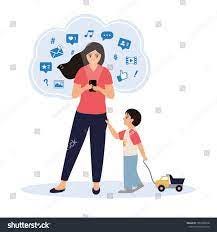5 FAMILY COMMUNICATION CHALLENGES THAT ARE RELEVANT IN TODAY’S DIGITAL AGE
Have you ever been to a restaurant during a family gathering, reunion, or any social occasion, where everyone seems to be engrossed in their own digital worlds rather than engaging in conversations?
I have encountered such situations, and they have led me to identify five family communication challenges that are particularly relevant in today’s digital age.

- The Allure of Screens:
People are often drawn to and glued to their gadget devices, seemingly unable to resist their captivating pull. These digital devices can distract us from talking face-to-face and spending time together. Just like we thought about talking virtually versus in real life, let’s consider why screens are so appealing.
Even though screens offer convenience and connection, we need to ask ourselves if they’re helping us truly connect with each other in meaningful ways. Just as we try to balance virtual and real conversations, finding the right balance with screens can decide whether they help us stay close as a family or pull us apart.
It’s worth pondering: How can we strike a balance between the convenience and connectivity of our digital devices, and the irreplaceable warmth and authenticity of face-to-face interactions that shape meaningful family relationships?

2. Social Media Distraction:
Have you ever observed family members immersed in scrolling through social media on their devices, even while in the presence of other family members?
Picture this:
A son or daughter excitedly wants to share the story of their fantastic day at school with their mother.
However, the mother absentmindedly responds, “It was great, honey,” all the while scrolling through social media, not making eye contact with his child.
Unbeknownst to them, the son or daughter is left with a subtle feeling that their mother doesn’t seem to genuinely care.

It can be quite disheartening, especially when it’s the parents, who should ideally be the role models within the family, setting such a precedent. This behaviour begs the question of the example we’re setting for our loved ones and how it might impact our collective ability to truly connect and communicate.
3. Virtual vs. Real Conversations:
We often rely on texting and messaging apps these days? Convenience, is it and I can just send it through my fingertips, what’s the rush, right?
It’s so easy to send a quick message, share a funny meme, or shoot off an emoji-filled response. But have you ever paused to think about the conversations we used to have with our family, face-to-face?
You might be thinking, “Well, I’m still talking to my family, even if it’s through my phone.” But here’s the thing: emojis can’t capture the warmth of a smile, and words on a screen can’t convey the full emotion behind someone’s voice.
Think about today’s busy world, where sitting down with family for heart-to-heart talks is becoming rare. The shared laughter, stories, and experiences that used to connect us have started slipping away. Yet, these are the talks that truly help us feel heard, understood, and close to each other.
I want you to imagine a scenario where you ask your son or daughter, especially one who tends to internalize their feelings or struggles with expressing themselves openly.
You will ask them, “Hey honey, how was your day?”
Their reply often comes in the form of an emoji-filled message like “It was great, Mom! 😊”
But here’s the question: are they genuinely, okay? They can’t fully encompass the intricacies of their day or their true emotions with just virtual conversation!

4. Endless Entertainment Options:
Think about all the different ways we can be entertained these days — streaming shows, playing online games, watching YouTube videos. Some might say, “Hey, these things can actually bring families together through multiplayer activities.”
But here’s the catch: while we might be doing things together virtually, are we really connecting like we used to? Playing an online game might have us teaming up, but we’re often talking through headsets, not face-to-face. Watching shows side by side might sound cozy, but we’re looking at screens, not each other.
Sure, it’s good to have fun together in new ways, but we shouldn’t forget the basics. Remember when families played board games, cooked meals, or just talked? Those were moments where we truly understood each other and made memories that mattered.

5. Tech at the Table:
Family dinner sounds great but what would be the meaning of family dinner with gadget devices at the table?
Believe it or not, the practices are common these days. While it might seem innocent, it disrupts the chance for the family to sit down, eat together, and share their daily experiences. This habit can further erode the foundation of open communication.
It’s essential to recognize that a family dinner loses its essence when each member is absorbed in their gadget, as the true value lies in shared moments of interaction and connection
In a world full of screens and gadgets, connecting with family can be tough. We’re hooked to screens, missing out on real talks. Social media and games distract us, and gadgets at the table don’t help.
But there’s a fix. We need to balance screens and chats. We can put down screens, talk face-to-face, and share stories. Let’s keep our family connections real and strong, because that’s what truly matters.

These are my opinion basis only not to mention gadget devices are absolutely bad.
What are your thoughts on these challenges? How do you view the role of gadgets in family communication?
